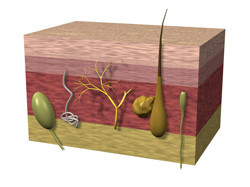Crossing the skin barrier
Drug delivery through the skin offers many advantages including a large surface area, direct access to the bloodstream avoiding first pass metabolism and disease transmission by needles. However, the uppermost layer of skin, the stratum corneum, prevents the penetration of substances by limiting both topical and transdermal bioavailability. The 'Novel thermoresponsive organic nanogels for topical gene delivery of RNA-based drugs' (NANOGEND) project has developed an organic nanogel to efficiently penetrate the skin barrier, deliver their payload and clear from the body without any adverse side effects. The carriers — micelles, are composed of polyethylene glycol (the hydrophilic block) and polyethylene sulphide (PEG-b-PPS). These hydrophobic PPS blocks form the core of the micelle, which can host lipophilic drugs. The hydrophilic PEG blocks make up the outer shell and stabilise the interface between the core and the external medium. Compared with classical surfactant micelles, PEG-b-PPS are very stable and retain the cargo drug for a longer time. The concentration of drug at the target site is high, a particularly valuable property for therapeutics. A fluorescent sensor is attached to the core and acts as an on/off switch when binding with flufenamic acid (FFA), the drug used as a model in the study. Micelle penetration as well as drug up-loading and release can be monitored using this fluorophore. Results showed that the micelles loaded with FFA penetrated the skin within a day, delivering drug volumes appropriate for the pharmaceutical formulation of FFA. Applications within the drug delivery area include skin cancer imaging and targeted therapeutics, immunomodulation and vaccine delivery via skin, antimicrobials and wound healing. Nano-tools are set to contribute to the clinical translation of nanotechnology to dermatology.



